Page 17 of 95
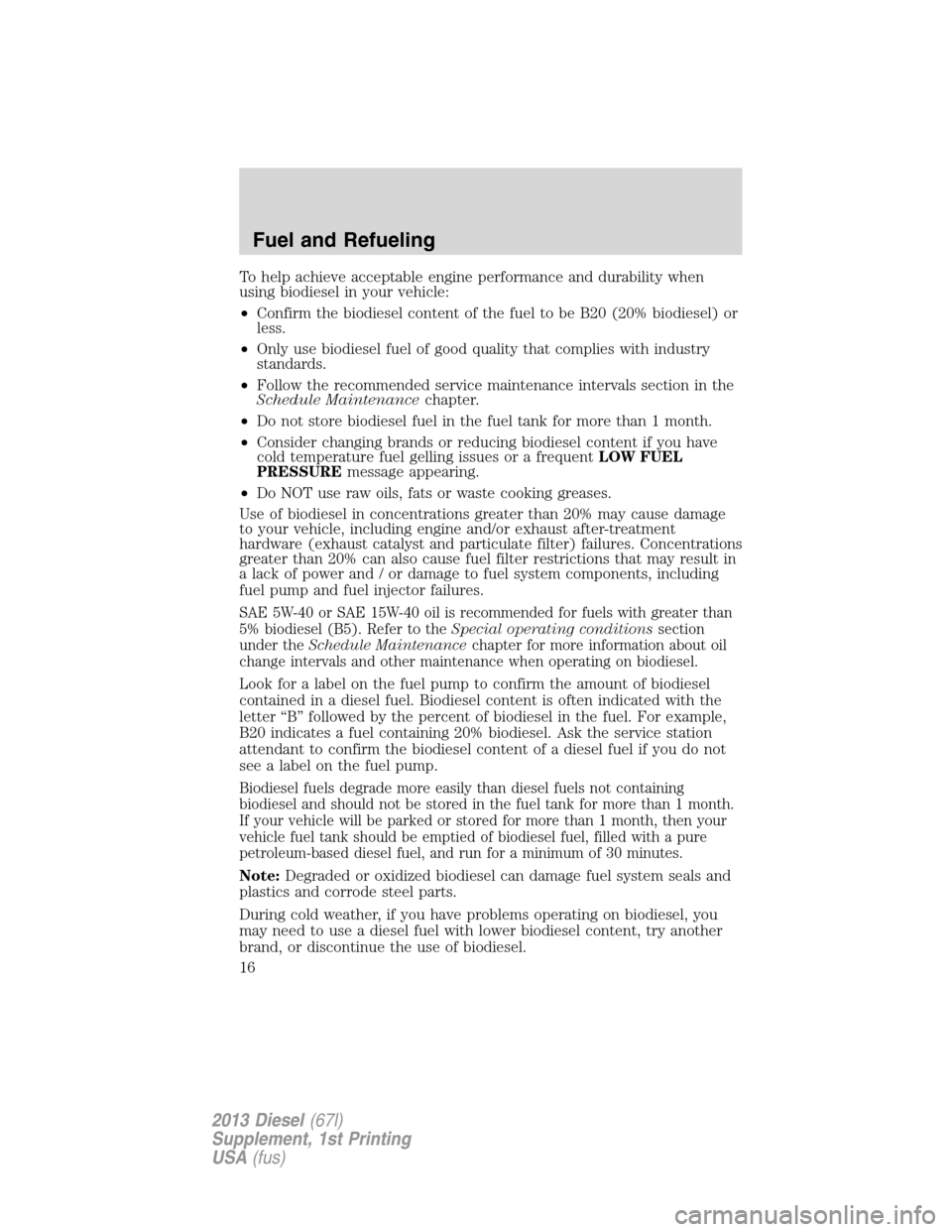
To help achieve acceptable engine performance and durability when
using biodiesel in your vehicle:
ŌĆóConfirm the biodiesel content of the fuel to be B20 (20% biodiesel) or
less.
ŌĆóOnly use biodiesel fuel of good quality that complies with industry
standards.
ŌĆóFollow the recommended service maintenance intervals section in the
Schedule Maintenancechapter.
ŌĆóDo not store biodiesel fuel in the fuel tank for more than 1 month.
ŌĆóConsider changing brands or reducing biodiesel content if you have
cold temperature fuel gelling issues or a frequentLOW FUEL
PRESSUREmessage appearing.
ŌĆóDo NOT use raw oils, fats or waste cooking greases.
Use of biodiesel in concentrations greater than 20% may cause damage
to your vehicle, including engine and/or exhaust after-treatment
hardware (exhaust catalyst and particulate filter) failures. Concentrations
greater than 20% can also cause fuel filter restrictions that may result in
a lack of power and / or damage to fuel system components, including
fuel pump and fuel injector failures.
SAE 5W-40 or SAE 15W-40 oil is recommended for fuels with greater than
5% biodiesel (B5). Refer to theSpecial operating conditionssection
under theSchedule Maintenancechapter for more information about oil
change intervals and other maintenance when operating on biodiesel.
Look for a label on the fuel pump to confirm the amount of biodiesel
contained in a diesel fuel. Biodiesel content is often indicated with the
letter ŌĆ£BŌĆØ followed by the percent of biodiesel in the fuel. For example,
B20 indicates a fuel containing 20% biodiesel. Ask the service station
attendant to confirm the biodiesel content of a diesel fuel if you do not
see a label on the fuel pump.
Biodiesel fuels degrade more easily than diesel fuels not containing
biodiesel and should not be stored in the fuel tank for more than 1 month.
If your vehicle will be parked or stored for more than 1 month, then your
vehicle fuel tank should be emptied of biodiesel fuel, filled with a pure
petroleum-based diesel fuel, and run for a minimum of 30 minutes.
Note:Degraded or oxidized biodiesel can damage fuel system seals and
plastics and corrode steel parts.
During cold weather, if you have problems operating on biodiesel, you
may need to use a diesel fuel with lower biodiesel content, try another
brand, or discontinue the use of biodiesel.
Fuel and Refueling
16
2013 Diesel(67l)
Supplement, 1st Printing
USA(fus)
Page 18 of 95
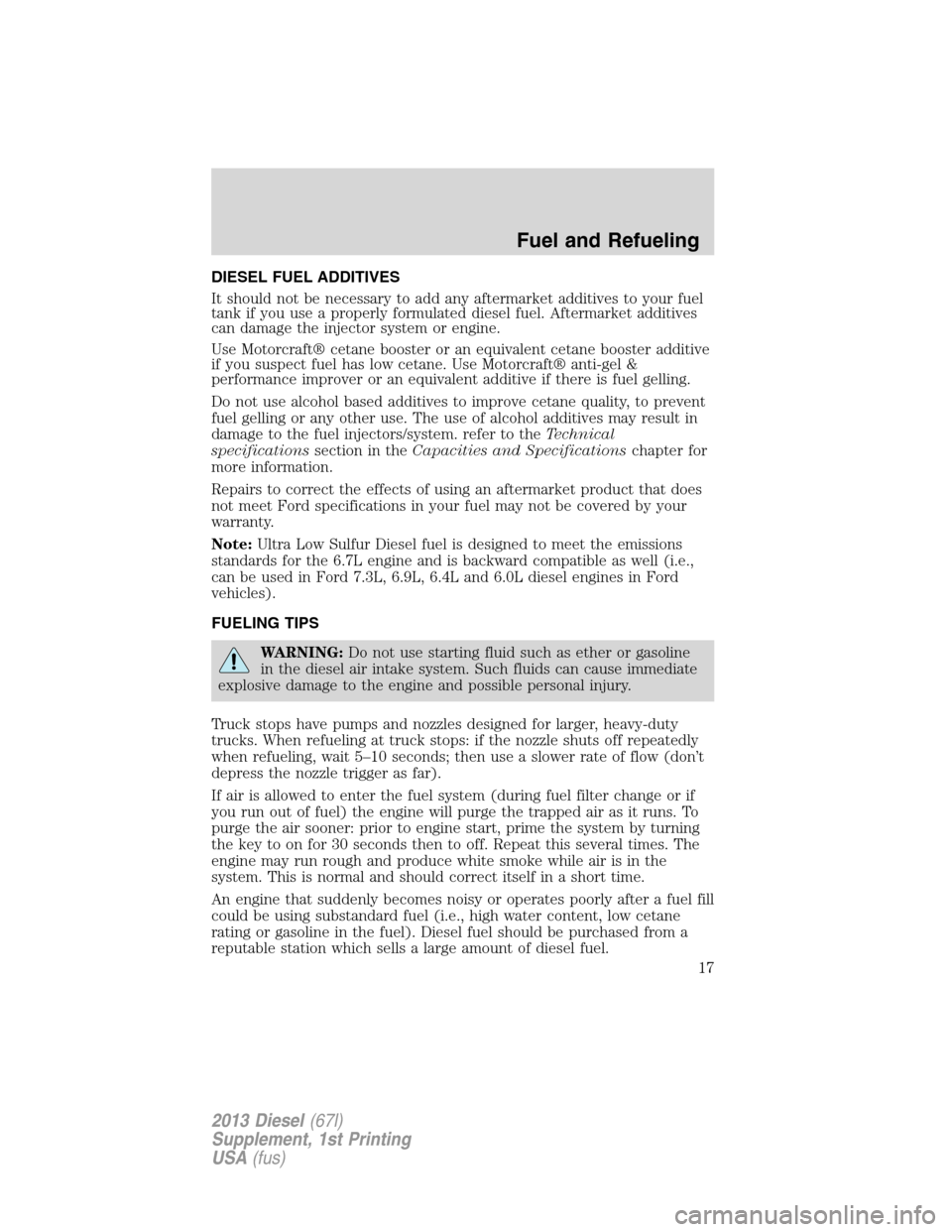
DIESEL FUEL ADDITIVES
It should not be necessary to add any aftermarket additives to your fuel
tank if you use a properly formulated diesel fuel. Aftermarket additives
can damage the injector system or engine.
Use Motorcraft® cetane booster or an equivalent cetane booster additive
if you suspect fuel has low cetane. Use Motorcraft® anti-gel &
performance improver or an equivalent additive if there is fuel gelling.
Do not use alcohol based additives to improve cetane quality, to prevent
fuel gelling or any other use. The use of alcohol additives may result in
damage to the fuel injectors/system. refer to theTechnical
specificationssection in theCapacities and Specificationschapter for
more information.
Repairs to correct the effects of using an aftermarket product that does
not meet Ford specifications in your fuel may not be covered by your
warranty.
Note:Ultra Low Sulfur Diesel fuel is designed to meet the emissions
standards for the 6.7L engine and is backward compatible as well (i.e.,
can be used in Ford 7.3L, 6.9L, 6.4L and 6.0L diesel engines in Ford
vehicles).
FUELING TIPS
WARNING:Do not use starting fluid such as ether or gasoline
in the diesel air intake system. Such fluids can cause immediate
explosive damage to the engine and possible personal injury.
Truck stops have pumps and nozzles designed for larger, heavy-duty
trucks. When refueling at truck stops: if the nozzle shuts off repeatedly
when refueling, wait 5ŌĆō10 seconds; then use a slower rate of flow (donŌĆÖt
depress the nozzle trigger as far).
If air is allowed to enter the fuel system (during fuel filter change or if
you run out of fuel) the engine will purge the trapped air as it runs. To
purge the air sooner: prior to engine start, prime the system by turning
the key to on for 30 seconds then to off. Repeat this several times. The
engine may run rough and produce white smoke while air is in the
system. This is normal and should correct itself in a short time.
An engine that suddenly becomes noisy or operates poorly after a fuel fill
could be using substandard fuel (i.e., high water content, low cetane
rating or gasoline in the fuel). Diesel fuel should be purchased from a
reputable station which sells a large amount of diesel fuel.
Fuel and Refueling
17
2013 Diesel(67l)
Supplement, 1st Printing
USA(fus)
Page 19 of 95
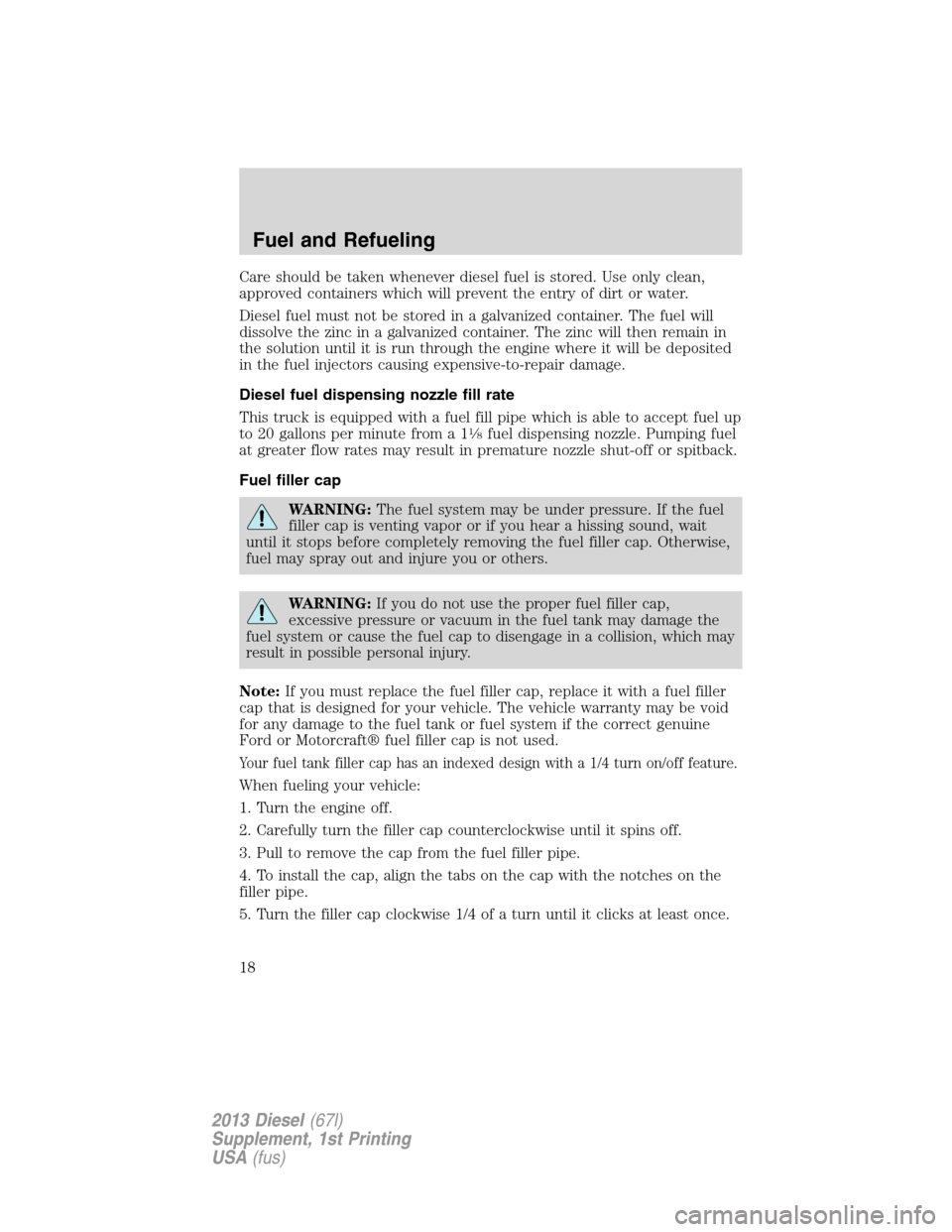
Care should be taken whenever diesel fuel is stored. Use only clean,
approved containers which will prevent the entry of dirt or water.
Diesel fuel must not be stored in a galvanized container. The fuel will
dissolve the zinc in a galvanized container. The zinc will then remain in
the solution until it is run through the engine where it will be deposited
in the fuel injectors causing expensive-to-repair damage.
Diesel fuel dispensing nozzle fill rate
This truck is equipped with a fuel fill pipe which is able to accept fuel up
to 20 gallons per minute from a 1
1�8fuel dispensing nozzle. Pumping fuel
at greater flow rates may result in premature nozzle shut-off or spitback.
Fuel filler cap
WARNING:The fuel system may be under pressure. If the fuel
filler cap is venting vapor or if you hear a hissing sound, wait
until it stops before completely removing the fuel filler cap. Otherwise,
fuel may spray out and injure you or others.
WARNING:If you do not use the proper fuel filler cap,
excessive pressure or vacuum in the fuel tank may damage the
fuel system or cause the fuel cap to disengage in a collision, which may
result in possible personal injury.
Note:If you must replace the fuel filler cap, replace it with a fuel filler
cap that is designed for your vehicle. The vehicle warranty may be void
for any damage to the fuel tank or fuel system if the correct genuine
Ford or Motorcraft® fuel filler cap is not used.
Your fuel tank filler cap has an indexed design with a 1/4 turn on/off feature.
When fueling your vehicle:
1. Turn the engine off.
2. Carefully turn the filler cap counterclockwise until it spins off.
3. Pull to remove the cap from the fuel filler pipe.
4. To install the cap, align the tabs on the cap with the notches on the
filler pipe.
5. Turn the filler cap clockwise 1/4 of a turn until it clicks at least once.
Fuel and Refueling
18
2013 Diesel(67l)
Supplement, 1st Printing
USA(fus)
Page 20 of 95
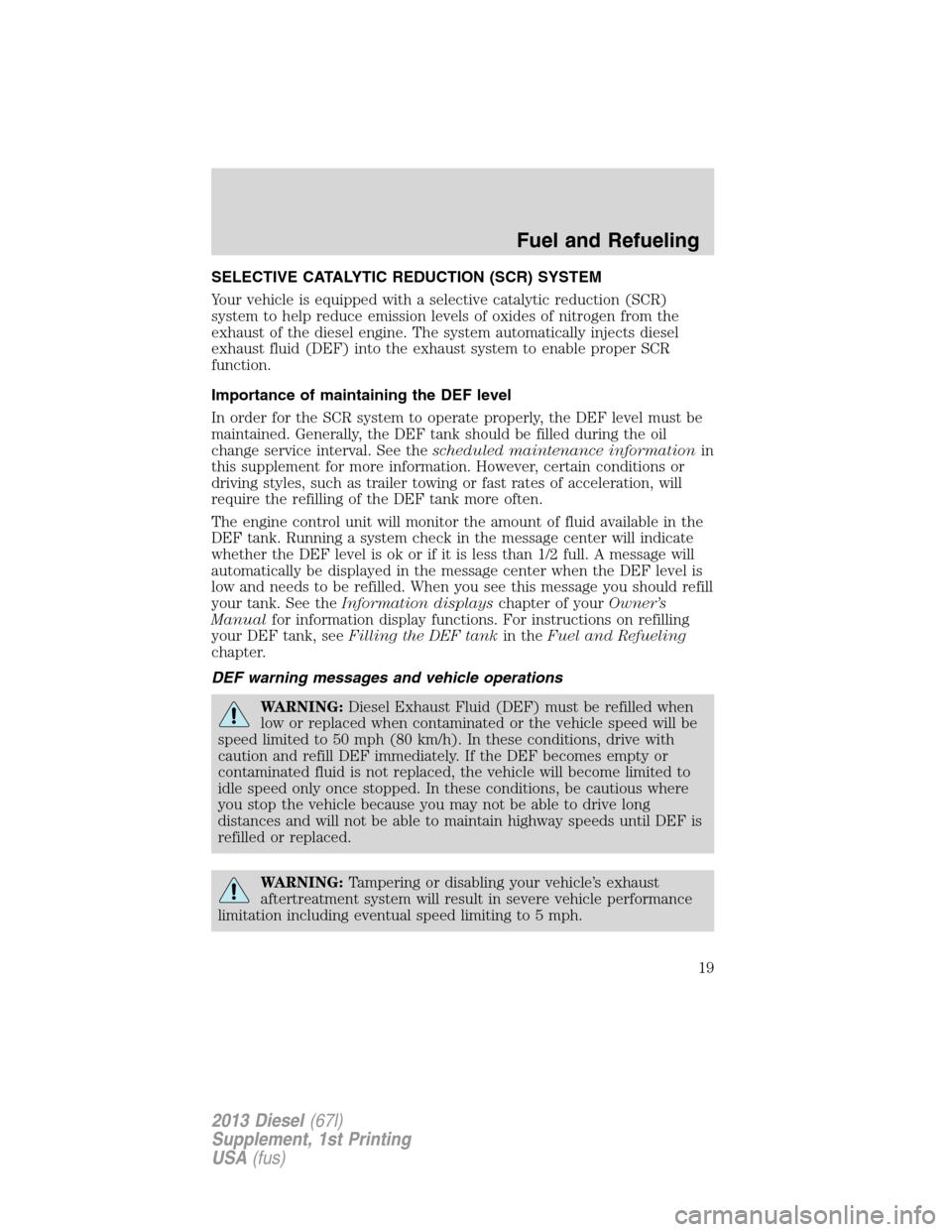
SELECTIVE CATALYTIC REDUCTION (SCR) SYSTEM
Your vehicle is equipped with a selective catalytic reduction (SCR)
system to help reduce emission levels of oxides of nitrogen from the
exhaust of the diesel engine. The system automatically injects diesel
exhaust fluid (DEF) into the exhaust system to enable proper SCR
function.
Importance of maintaining the DEF level
In order for the SCR system to operate properly, the DEF level must be
maintained. Generally, the DEF tank should be filled during the oil
change service interval. See thescheduled maintenance informationin
this supplement for more information. However, certain conditions or
driving styles, such as trailer towing or fast rates of acceleration, will
require the refilling of the DEF tank more often.
The engine control unit will monitor the amount of fluid available in the
DEF tank. Running a system check in the message center will indicate
whether the DEF level is ok or if it is less than 1/2 full. A message will
automatically be displayed in the message center when the DEF level is
low and needs to be refilled. When you see this message you should refill
your tank. See theInformation displayschapter of yourOwnerŌĆÖs
Manualfor information display functions. For instructions on refilling
your DEF tank, seeFilling the DEF tankin theFuel and Refueling
chapter.
DEF warning messages and vehicle operations
WARNING:Diesel Exhaust Fluid (DEF) must be refilled when
low or replaced when contaminated or the vehicle speed will be
speed limited to 50 mph (80 km/h). In these conditions, drive with
caution and refill DEF immediately. If the DEF becomes empty or
contaminated fluid is not replaced, the vehicle will become limited to
idle speed only once stopped. In these conditions, be cautious where
you stop the vehicle because you may not be able to drive long
distances and will not be able to maintain highway speeds until DEF is
refilled or replaced.
WARNING:Tampering or disabling your vehicleŌĆÖs exhaust
aftertreatment system will result in severe vehicle performance
limitation including eventual speed limiting to 5 mph.
Fuel and Refueling
19
2013 Diesel(67l)
Supplement, 1st Printing
USA(fus)
Page 21 of 95
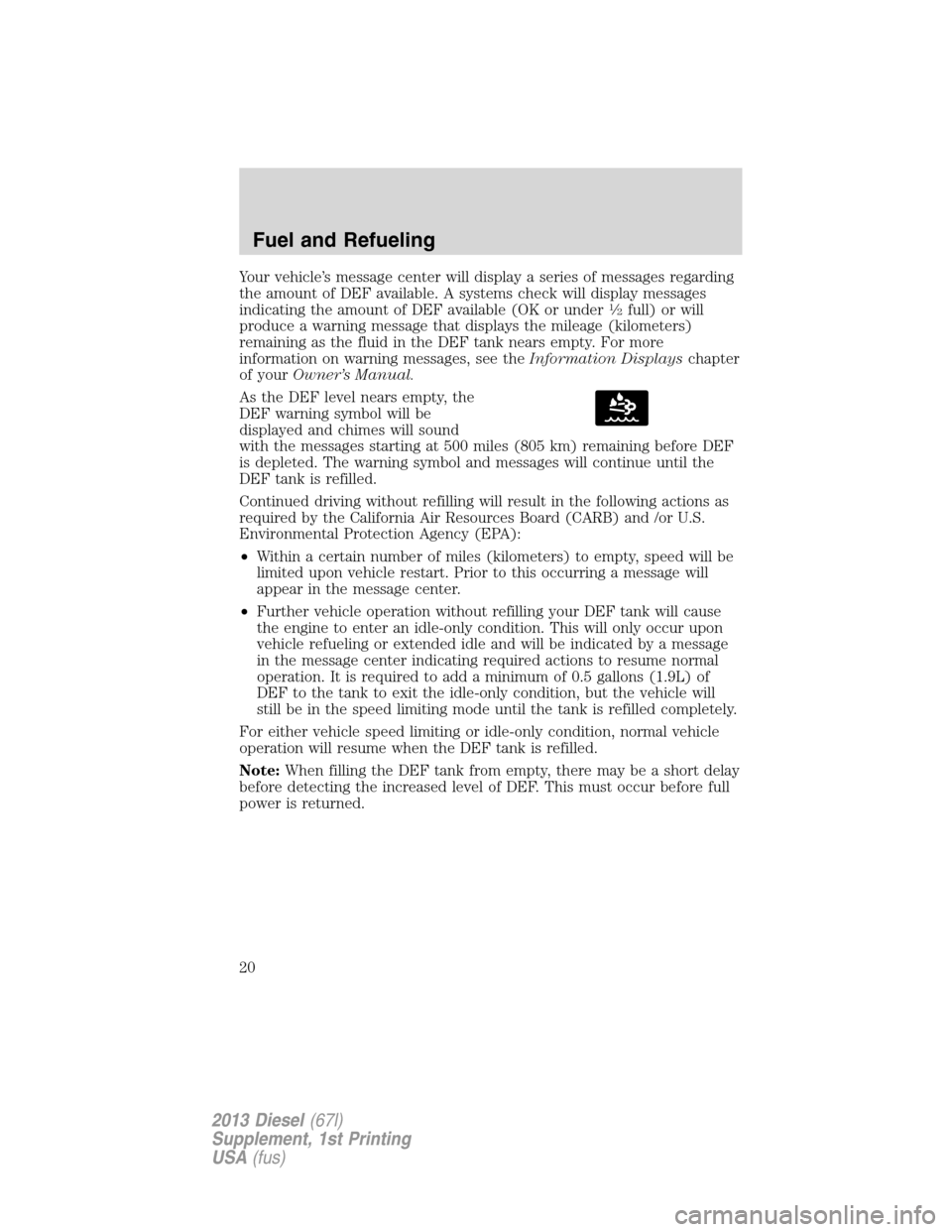
Your vehicleŌĆÖs message center will display a series of messages regarding
the amount of DEF available. A systems check will display messages
indicating the amount of DEF available (OK or under
1�2full) or will
produce a warning message that displays the mileage (kilometers)
remaining as the fluid in the DEF tank nears empty. For more
information on warning messages, see theInformation Displayschapter
of yourOwnerŌĆÖs Manual.
As the DEF level nears empty, the
DEF warning symbol will be
displayed and chimes will sound
with the messages starting at 500 miles (805 km) remaining before DEF
is depleted. The warning symbol and messages will continue until the
DEF tank is refilled.
Continued driving without refilling will result in the following actions as
required by the California Air Resources Board (CARB) and /or U.S.
Environmental Protection Agency (EPA):
ŌĆóWithin a certain number of miles (kilometers) to empty, speed will be
limited upon vehicle restart. Prior to this occurring a message will
appear in the message center.
ŌĆóFurther vehicle operation without refilling your DEF tank will cause
the engine to enter an idle-only condition. This will only occur upon
vehicle refueling or extended idle and will be indicated by a message
in the message center indicating required actions to resume normal
operation. It is required to add a minimum of 0.5 gallons (1.9L) of
DEF to the tank to exit the idle-only condition, but the vehicle will
still be in the speed limiting mode until the tank is refilled completely.
For either vehicle speed limiting or idle-only condition, normal vehicle
operation will resume when the DEF tank is refilled.
Note:When filling the DEF tank from empty, there may be a short delay
before detecting the increased level of DEF. This must occur before full
power is returned.
Fuel and Refueling
20
2013 Diesel(67l)
Supplement, 1st Printing
USA(fus)
Page 22 of 95
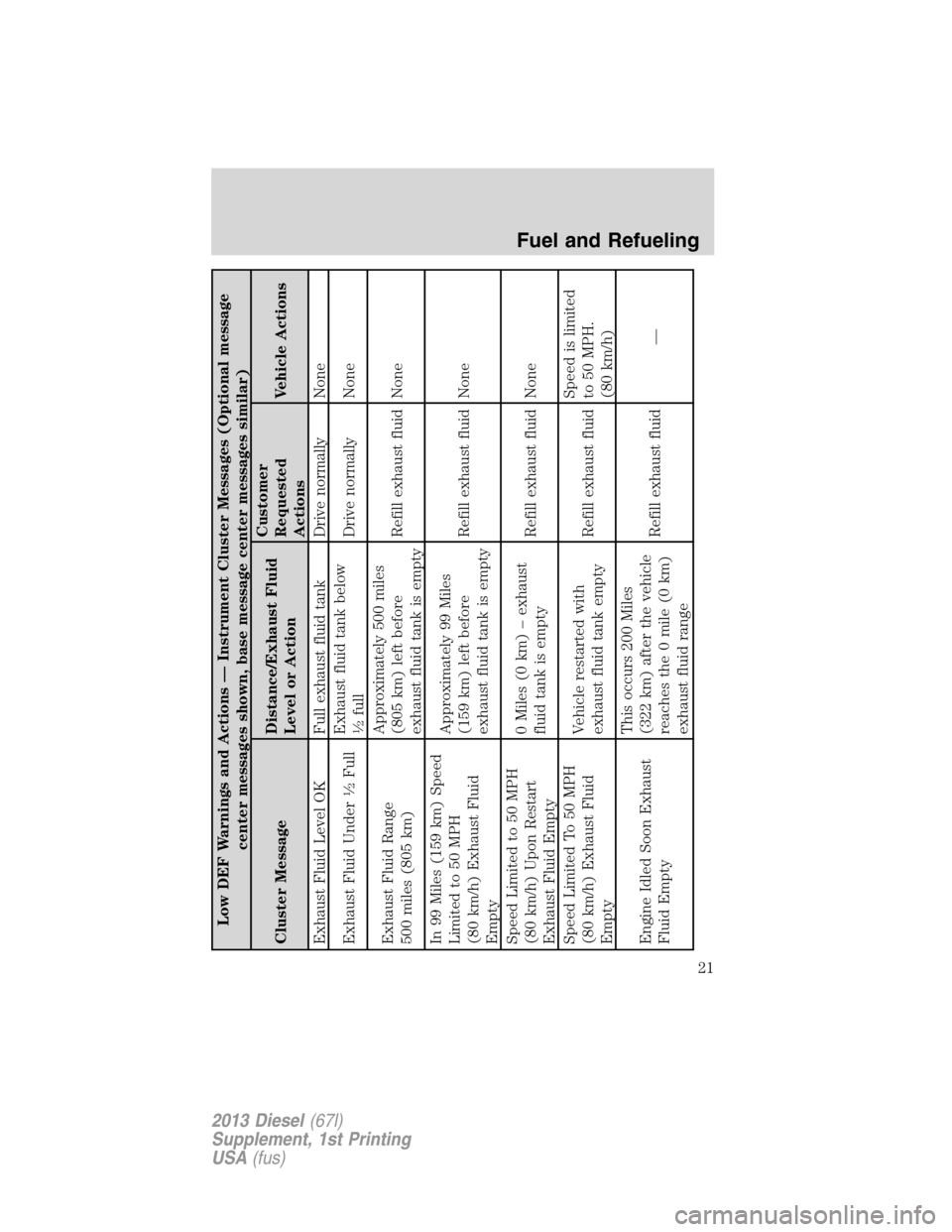
Low DEF Warnings and Actions ŌĆö Instrument Cluster Messages (Optional message
center messages shown, base message center messages similar)
Cluster MessageDistance/Exhaust Fluid
Level or ActionCustomer
Requested
ActionsVehicle Actions
Exhaust Fluid Level OK Full exhaust fluid tank Drive normally None
Exhaust Fluid Under
1�2FullExhaust fluid tank below
1�2fullDrive normally None
Exhaust Fluid Range
500 miles (805 km)Approximately 500 miles
(805 km) left before
exhaust fluid tank is emptyRefill exhaust fluid None
In 99 Miles (159 km) Speed
Limited to 50 MPH
(80 km/h) Exhaust Fluid
EmptyApproximately 99 Miles
(159 km) left before
exhaust fluid tank is emptyRefill exhaust fluid None
Speed Limited to 50 MPH
(80 km/h) Upon Restart
Exhaust Fluid Empty0 Miles (0 km) ŌĆō exhaust
fluid tank is emptyRefill exhaust fluid None
Speed Limited To 50 MPH
(80 km/h) Exhaust Fluid
EmptyVehicle restarted with
exhaust fluid tank emptyRefill exhaust fluidSpeed is limited
to 50 MPH.
(80 km/h)
Engine Idled Soon Exhaust
Fluid EmptyThis occurs 200 Miles
(322 km) after the vehicle
reaches the 0 mile (0 km)
exhaust fluid rangeRefill exhaust fluid ŌĆö
Fuel and Refueling
21
2013 Diesel(67l)
Supplement, 1st Printing
USA(fus)
Page 23 of 95
Low DEF Warnings and Actions ŌĆö Instrument Cluster Messages (Optional message
center messages shown, base message center messages similar)
Cluster MessageDistance/Exhaust Fluid
Level or ActionCustomer
Requested
ActionsVehicle Actions
Engine Idled-See OwnerŌĆÖs
Manual Exhaust Fluid EmptyThis occurs when the
exhaust fluid is empty and:
ŌĆóThe vehicleŌĆÖs diesel fuel
tank is refueled or,
ŌĆóthe engine is shut off for
10 minutes or,
ŌĆóthe engine is idling with
the parking brake engaged
for 60 minutes.Refill exhaust fluidEngine is limited
to idle ONLY
Fuel and Refueling
22
2013 Diesel(67l)
Supplement, 1st Printing
USA(fus)
Page 24 of 95
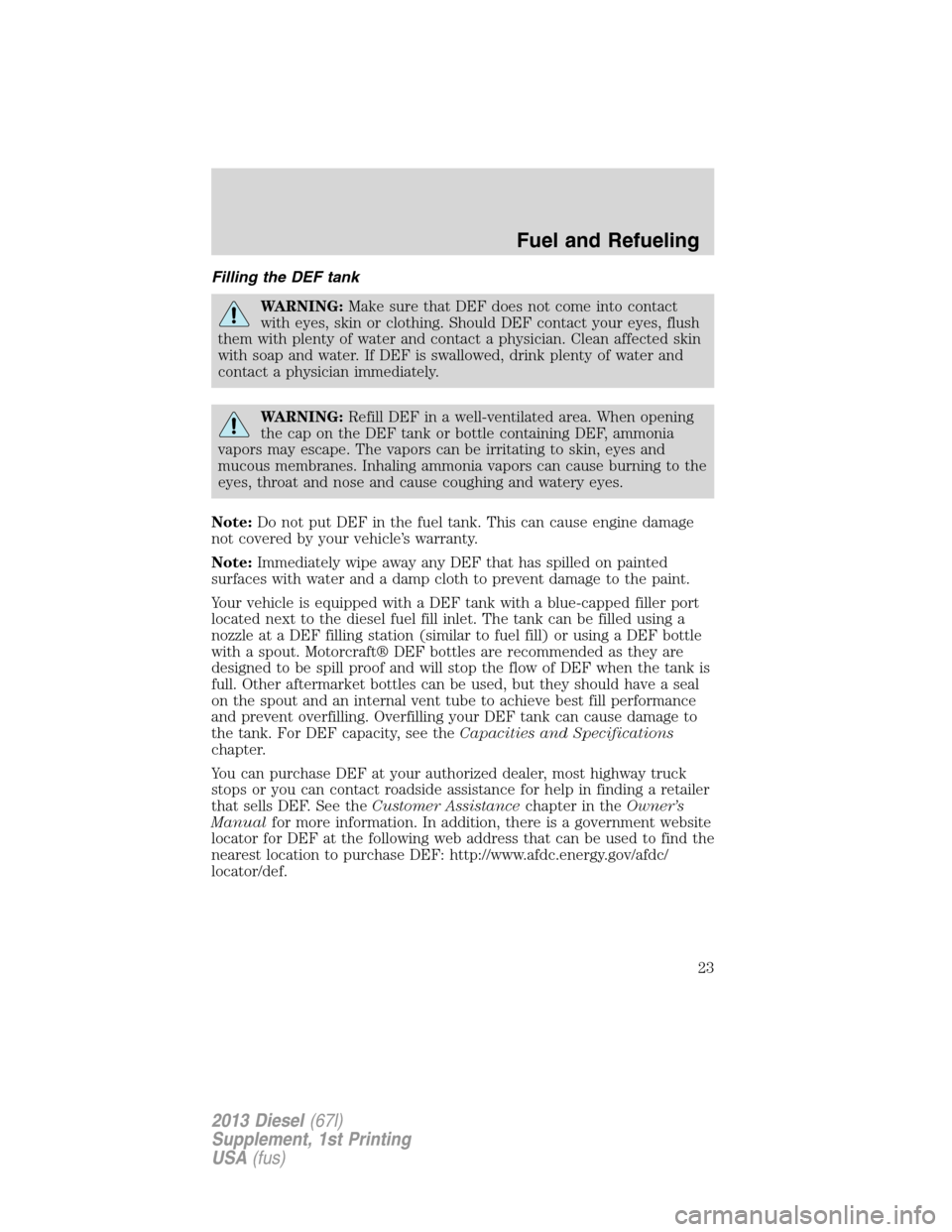
Filling the DEF tank
WARNING:Make sure that DEF does not come into contact
with eyes, skin or clothing. Should DEF contact your eyes, flush
them with plenty of water and contact a physician. Clean affected skin
with soap and water. If DEF is swallowed, drink plenty of water and
contact a physician immediately.
WARNING:Refill DEF in a well-ventilated area. When opening
the cap on the DEF tank or bottle containing DEF, ammonia
vapors may escape. The vapors can be irritating to skin, eyes and
mucous membranes. Inhaling ammonia vapors can cause burning to the
eyes, throat and nose and cause coughing and watery eyes.
Note:Do not put DEF in the fuel tank. This can cause engine damage
not covered by your vehicleŌĆÖs warranty.
Note:Immediately wipe away any DEF that has spilled on painted
surfaces with water and a damp cloth to prevent damage to the paint.
Your vehicle is equipped with a DEF tank with a blue-capped filler port
located next to the diesel fuel fill inlet. The tank can be filled using a
nozzle at a DEF filling station (similar to fuel fill) or using a DEF bottle
with a spout. Motorcraft® DEF bottles are recommended as they are
designed to be spill proof and will stop the flow of DEF when the tank is
full. Other aftermarket bottles can be used, but they should have a seal
on the spout and an internal vent tube to achieve best fill performance
and prevent overfilling. Overfilling your DEF tank can cause damage to
the tank. For DEF capacity, see theCapacities and Specifications
chapter.
You can purchase DEF at your authorized dealer, most highway truck
stops or you can contact roadside assistance for help in finding a retailer
that sells DEF. See theCustomer Assistancechapter in theOwnerŌĆÖs
Manualfor more information. In addition, there is a government website
locator for DEF at the following web address that can be used to find the
nearest location to purchase DEF: http://www.afdc.energy.gov/afdc/
locator/def.
Fuel and Refueling
23
2013 Diesel(67l)
Supplement, 1st Printing
USA(fus)